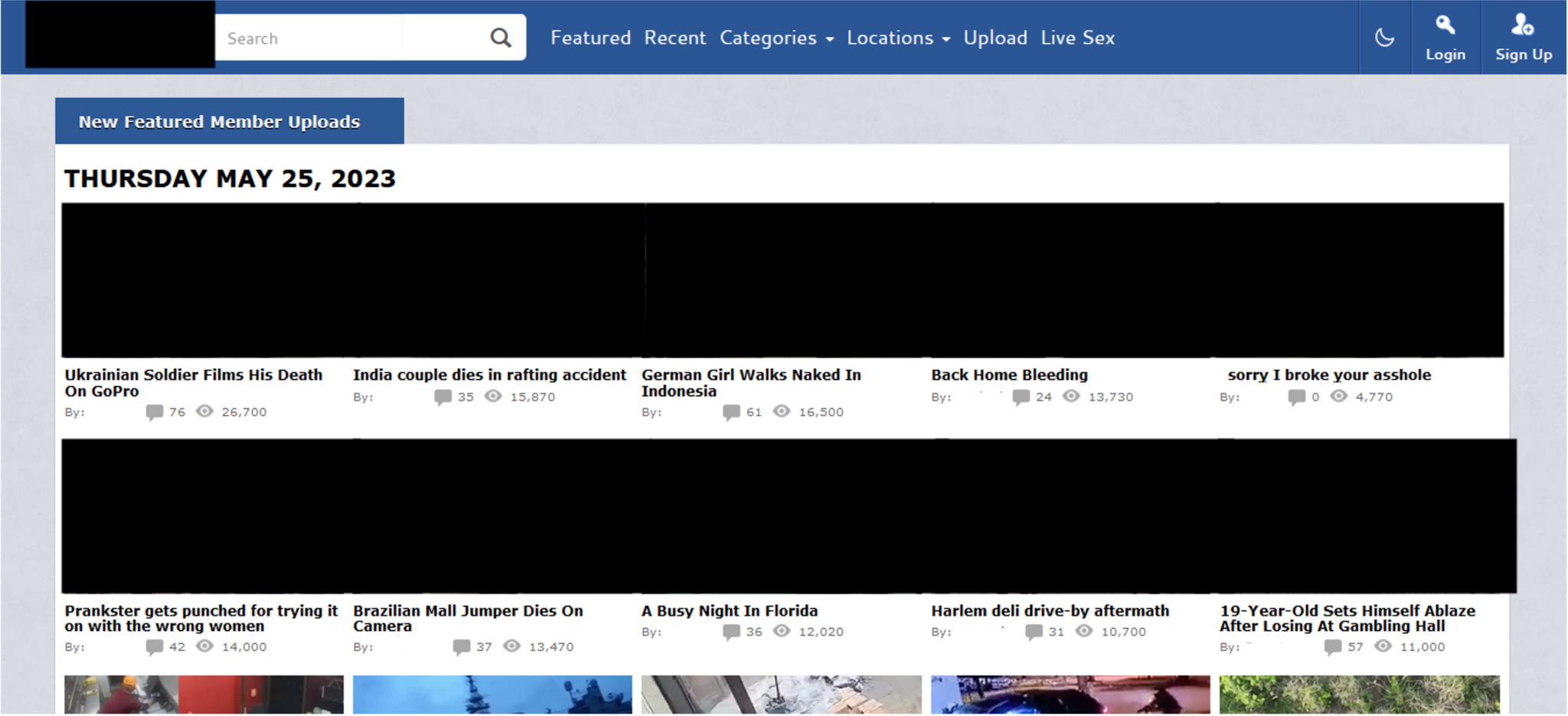Unmasking Gore Videos: The Dark Reality And Its Perils
In an increasingly interconnected digital world, a disturbing phenomenon continues to proliferate: gore videos. These graphic depictions of extreme violence, often featuring real-life accidents, murders, dismemberments, and executions, are not just fleeting images but deeply unsettling content that can have profound psychological and societal impacts. While curiosity might draw some, the true nature of these videos and the ecosystems that support them are far more sinister than many realize, posing significant risks to mental well-being and perpetuating cycles of violence.
The accessibility of such content, whether through obscure corners of the dark web or, alarmingly, sometimes seeping into mainstream platforms, raises critical questions about digital responsibility, ethical consumption of media, and the psychological toll on viewers. Understanding the origins, distribution, and consequences of engaging with **gore videos** is crucial for navigating the complex digital landscape and protecting ourselves and future generations from their insidious reach.
Table of Contents
- Understanding Gore Videos: A Disturbing Phenomenon
- The Allure and Addiction: Why People Watch Gore Videos
- The Real-World Impact: Victims and Perpetrators
- The Dark Web and Distribution Channels
- Psychological and Emotional Consequences of Exposure
- Legal and Ethical Implications of Gore Videos
- Protecting Yourself and Others: Navigating the Digital Landscape
- Moving Forward: A Call for Awareness and Responsibility
Understanding Gore Videos: A Disturbing Phenomenon
**Gore videos** represent a subgenre of media characterized by explicit, often unsimulated depictions of violence, injury, and death. Unlike fictional horror films, these videos aim to portray real-life brutality, often showcasing the aftermath of horrific accidents, acts of torture, or executions. Their primary purpose is to shock, disturb, and sometimes even entertain a niche audience drawn to extreme content. Websites like Goresee and Xgore.net are known as hubs for such material, often featuring "latest murder photos and videos," alongside graphic incidents like "beheading, dismemberment, execution of victims by gangs." These platforms often market themselves with descriptions like "Explore the unfiltered reality of life and death with our gore videos collection, Witness shocking content such as accidents, murders, and other graphic incidents, all updated with the." They frequently carry stark warnings: "This website contains extremely realistic images and videos of violence, Please consider carefully before viewing, as i bear no responsibility for your reactions or actions afterward." The content varies widely but consistently pushes the boundaries of human endurance and ethical viewing. From "gruesome gore collection topics shockumentary, death film, death, autopsy" to specific categories like "pure gore" found on "deep gore tube website" where "the most brutal and extreme gore videos" are stored, the range of depravity is vast. These collections are not just random uploads; they are often curated, sometimes even by users creating playlists like "All gore/brutal and death scenes (18+) by lenny renton • playlist • 45 videos • 91,565 views play all," indicating a dedicated audience. The existence of "gore language Japanese item size 4.1g" suggests a global reach and specific sub-niches within this disturbing category. The sheer volume and explicit nature of these videos underscore a troubling demand for such extreme media.The Allure and Addiction: Why People Watch Gore Videos
The question of why anyone would choose to "watch many gore videos that will make you" uncomfortable, disturbed, or even nauseated is complex. It's a psychological puzzle with multiple facets, ranging from morbid curiosity to a search for authenticity in a world often perceived as sanitized. For some, it's a way to confront mortality, to peek behind the veil of the unknown without directly experiencing danger. Others might be seeking a thrill, a jolt of adrenaline that conventional entertainment cannot provide. The raw, unfiltered nature of **gore videos** offers a stark contrast to scripted media, presenting what some viewers perceive as "the unfiltered reality of life and death." This morbid fascination can, however, quickly spiral into an unhealthy obsession. The human brain is wired to respond to novelty and intense stimuli, and graphic content, by its very nature, is both. Repeated exposure can lead to a desensitization effect, where the initial shock wears off, prompting viewers to seek increasingly extreme content to achieve the same level of emotional response. This cycle can be addictive, drawing individuals deeper into a dark rabbit hole of disturbing imagery.Psychological Drivers Behind Viewing Graphic Content
Several psychological theories attempt to explain the draw of graphic content. One prevalent theory points to morbid curiosity – an innate human desire to understand the darker aspects of existence, death, and suffering. It's a primal urge to witness what is typically hidden, to confront taboos. For some, viewing **gore videos** might be a way to feel more alive, to appreciate their own safety and well-being in contrast to the suffering depicted. Others might be drawn to it out of a sense of power or control, feeling immune to the horrors on screen. Another driver can be a search for authenticity. In an age of pervasive digital manipulation and carefully curated realities, the raw, unedited nature of real-life violence can be perceived as "real," offering a stark, unvarnished truth. This quest for authenticity can be particularly strong in individuals who feel disconnected or disillusioned with mainstream media. Furthermore, some viewers may be grappling with their own trauma or psychological issues, finding a perverse form of catharsis or validation in witnessing extreme suffering, though this is often a maladaptive coping mechanism.The Desensitization Effect
One of the most significant and concerning consequences of repeated exposure to **gore videos** is desensitization. Initially, viewers might experience strong negative emotional reactions – shock, disgust, fear, sadness. However, with continued viewing, these reactions diminish. The brain adapts, and what was once horrifying becomes normalized. This process isn't limited to emotional responses; it can also affect cognitive and behavioral patterns. Individuals may become less empathetic towards real-world suffering, more tolerant of violence, and even more prone to aggressive thoughts or behaviors. This desensitization can extend beyond the screen, impacting real-life interactions and perceptions. A person who is constantly exposed to extreme violence might start to view it as commonplace, losing the ability to distinguish between the severity of different acts of aggression. This erosion of empathy and moral boundaries is a grave concern, particularly for younger viewers whose moral compasses are still developing. It can lead to a distorted perception of reality, where violence is not only normalized but perhaps even seen as a solution or an inevitable part of life.The Real-World Impact: Victims and Perpetrators
It is crucial to remember that behind every **gore video** lies a real victim, real suffering, and often, real perpetrators. These are not actors or special effects; they are individuals whose lives have been tragically and brutally ended or irrevocably altered. The circulation of these videos not only disrespects the deceased and their families but also serves to glorify and perpetuate the violence itself. In many cases, the creation and distribution of such content are integral parts of criminal enterprises, particularly organized crime. For instance, the "Data Kalimat" references how "The captive, said to oversee cjng operations in nanchital, agua dulce, and las choapas, reportedly confessed to fuel theft from." This snippet, while not explicitly a gore video, highlights the real-world criminal activities that often precede or are depicted in such videos. Cartels and criminal gangs frequently use extreme violence, including "beheading, dismemberment, execution of victims," not just as a means of control but also as a form of psychological warfare and recruitment. They film and distribute these acts to instill fear, demonstrate power, and send messages to rivals or the public. "The group has exploited the region’s destabilization to acquire new weapons and strengthen its presence," further illustrating how the violence depicted in these videos is often part of a broader, organized criminal strategy that thrives on chaos and fear. The existence of these videos fuels the very industries that create them, making viewers, however unwittingly, complicit in their harmful cycle.The Dark Web and Distribution Channels
While some graphic content might occasionally surface on mainstream platforms due to moderation failures, the primary distribution channels for the most extreme **gore videos** are often found on the dark web or in highly specialized, less regulated corners of the internet. Websites explicitly designed as "hubs for gore videos" like Goresee and Xgore.net, or specific categories such as the "pure gore" section on "deep gore tube website," operate outside the conventional internet, making them difficult to monitor and shut down. These platforms thrive on anonymity and a lack of accountability, allowing users to upload and share content that would be immediately removed elsewhere. The very architecture of the dark web, with its encrypted networks and decentralized nature, provides a haven for such illicit content. It allows for the creation of communities where individuals with a shared interest in extreme violence can connect, exchange, and even request specific types of videos. This ecosystem creates a self-sustaining cycle, where demand drives supply, and the lack of oversight ensures a constant flow of new, increasingly graphic material.The Anonymity Factor
The anonymity offered by the dark web is a double-edged sword. While it provides a degree of privacy for legitimate users, it also shields those engaged in illegal and harmful activities. For individuals who create and distribute **gore videos**, anonymity means they can operate with less fear of legal repercussions. This encourages the proliferation of content that would otherwise be suppressed. Viewers, too, often feel a sense of anonymity, which can lower inhibitions and lead them to explore content they might otherwise avoid. This perceived safety can lead to a false sense of security, making individuals more vulnerable to the psychological impacts of viewing such disturbing material. The lack of identifiable user data also makes it incredibly challenging for law enforcement agencies to track down perpetrators and dismantle these networks, allowing them to grow and evolve largely unchecked.The Role of Social Media and Mainstream Platforms
Despite the prevalence of dedicated **gore media** sites, the occasional leakage of graphic content onto mainstream social media platforms poses a significant challenge. Viral trends, live streaming capabilities, and the sheer volume of user-generated content make it difficult for platforms to filter everything. A single video can quickly spread, reaching millions of unsuspecting users before it is detected and removed. This accidental exposure can be particularly traumatizing for individuals who are not actively seeking such content. When graphic content appears on platforms like Twitter, Facebook, or TikTok, it often sparks public outcry and highlights the ongoing struggle between content moderation and rapid dissemination. While these platforms invest heavily in AI and human moderators, the sheer scale of uploads means some material inevitably slips through. This underscores the need for continuous vigilance, robust reporting mechanisms, and user education on how to avoid and report such content, protecting the wider public from inadvertent exposure to **gore videos**.Psychological and Emotional Consequences of Exposure
The psychological and emotional toll of viewing **gore videos** can be severe and long-lasting. Even a single exposure can be traumatizing, leading to symptoms akin to post-traumatic stress disorder (PTSD), including flashbacks, nightmares, anxiety, and an exaggerated startle response. For individuals with pre-existing mental health conditions, the impact can be even more profound, exacerbating symptoms of depression, anxiety disorders, or even triggering psychotic episodes. The graphic nature of the content can lead to a sense of pervasive fear and a distorted view of the world as a dangerous and violent place. Beyond acute trauma, chronic exposure can lead to emotional numbing, a reduced capacity for empathy, and a desensitization to violence, as discussed earlier. This can affect personal relationships, professional conduct, and overall quality of life. Children and adolescents are particularly vulnerable, as their brains are still developing, making them more susceptible to the negative impacts of such content. Exposure can interfere with their emotional development, instill fear, and even influence aggressive behaviors or thoughts. The long-term effects on a generation growing up with easy access to such material are still being understood but are a cause for significant concern among mental health professionals.Legal and Ethical Implications of Gore Videos
The creation, distribution, and even viewing of **gore videos** carry significant legal and ethical ramifications. In many jurisdictions, the creation of such content, especially when it involves torture, murder, or child abuse, constitutes severe criminal offenses. Perpetrators can face lengthy prison sentences and heavy fines. Laws are increasingly being adapted to address the digital dissemination of such material, with some countries enacting legislation specifically targeting the hosting or sharing of extreme violent content. However, the international nature of the internet and the anonymity of the dark web make enforcement incredibly challenging. Ethically, the existence of **gore videos** raises profound questions about human dignity, privacy, and the commodification of suffering. The victims in these videos are stripped of their dignity, their final moments exploited for perverse entertainment or criminal messaging. The act of viewing such content, even out of curiosity, can be seen as implicitly condoning or contributing to a market that thrives on human suffering. There's a moral imperative to consider the source of the content, the intent behind its creation, and the impact its viewing has, not just on the individual viewer but on the broader societal landscape. The ethical dilemma extends to technology companies and internet service providers, who grapple with the immense challenge of policing content while upholding free speech, a balance that becomes incredibly precarious when dealing with extreme violence.Protecting Yourself and Others: Navigating the Digital Landscape
In a world where **gore videos** unfortunately exist, proactive measures are essential for self-protection and safeguarding others, especially vulnerable populations like children. The first line of defense is awareness: understanding that such content exists and recognizing its harmful potential. Avoid seeking out or clicking on suspicious links, especially those promising shocking or explicit material. If you encounter such content inadvertently, immediately close the tab or application and report it to the platform. Most social media and content-sharing sites have robust reporting mechanisms for graphic violence. For parents and guardians, open communication with children about online dangers is paramount. Educate them about the existence of disturbing content, the importance of not clicking on unknown links, and the need to report anything that makes them feel uncomfortable or scared. Utilizing parental control software and monitoring internet activity can also provide an additional layer of protection. Furthermore, fostering critical media literacy skills can help individuals of all ages discern between real and fake content, and understand the manipulative tactics often employed by those who create and distribute harmful material. Supporting organizations that work to combat online exploitation and advocating for stronger legal frameworks against the dissemination of extreme violence are also crucial steps.Moving Forward: A Call for Awareness and Responsibility
The proliferation of **gore videos** is a stark reminder of the darker corners of the internet and the enduring human capacity for both cruelty and morbid curiosity. From the chilling realities of cartel violence, where "the captive, said to oversee cjng operations in nanchital, agua dulce, and las choapas, reportedly confessed to fuel theft from," to the curated collections on sites like "Goresee" and "Xgore.net," the ecosystem of extreme graphic content is complex and deeply unsettling. These videos, depicting "beheading, dismemberment, execution of victims by gangs," are not just disturbing images; they are fragments of real human suffering, often distributed by groups that "exploited the region’s destabilization to acquire new weapons and strengthen its presence." Understanding the psychological allure, the real-world impact, and the insidious distribution channels of **gore videos** is the first step towards mitigating their harm. It is a collective responsibility to advocate for a safer digital environment, support victims, and educate ourselves and future generations about the profound dangers of engaging with such material. By fostering digital literacy, promoting empathy, and demanding greater accountability from online platforms, we can work towards a future where human suffering is not commodified for entertainment or propaganda. Let us choose awareness over morbid curiosity, responsibility over passive consumption, and protection over indifference. What are your thoughts on the psychological impact of exposure to graphic content? Share your perspectives and experiences in the comments below, and consider sharing this article to raise awareness about this critical issue. For more insights into digital safety and mental well-being in the online age, explore our other articles on internet ethics and responsible media consumption.- Sondra Blust Only Fans Free
- Secret Therapy Leaks
- Mark Wiens Wife
- Christian Keyes Girlfriend
- Link Unblocker

Remembering Lesley Gore, Singer and Feminist Icon | Vogue

Where To Watch Gore Videos: A Comprehensive Guide To Finding The Best

Gore and violent extremism: How extremist groups exploit ‘gore’ sites